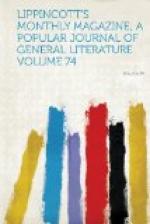of the subsequently famous “Elia” chased
butterflies across the velvety sward. “The
Temple Garden,” says Mr. Walter Thornbury, “has
probably been a garden from the time the white-robed
Templars first came from Holborn and settled by the
river-side.” It covers an expanse of three
acres, and its gay flower-beds, umbrageous trees,
and emerald turf make it a veritable oasis to the
inhabitants, and especially to the children, of that
corner of the great metropolis. A pillar sundial
in the centre of the grass bears the date 1770, and
the iron gate, surmounted by a winged horse, which
guards the entrance from the terrace, was erected in
1730. East of the sundial is a hoary old sycamore,
sole survivor of three sisters, carefully protected
by railings, under whose grateful shade, says local
tradition, Johnson and Goldsmith were wont to chat.
In the Middle Temple Garden stands a venerable catalpa-tree,
planted by Sir Matthew Hale, “one of the most
eminent of lawyers and excellent of men.”
The scene in “King Henry the Sixth,"[A] where
the partisans of the rival houses of Lancaster and
York assume the distinctive badges of the white and
red rose, is laid in the Temple Garden. “Toward
evening,” says Dr. Dibdin, “it was the
fashion for the leading counsel to promenade during
the summer months in the Temple Gardens. Cocked
hats and ruffles, with satin small-clothes, at that
time constituted the usual evening dress.”
Anciently, the “moots” were held on the
terrace of the Garden at five of the clock in the long
summer evenings.
[Footnote A: Part I., act 2, scene 4.]
The great hall of the Middle Temple is one of the
finest Elizabethan structures in the metropolis.
It was commenced in 1562, when the old hall was converted
into chambers, consumed a decade in building, and is
of grand proportions. It is a hundred feet long,
and the massive beauty of the glossy oaken roof, almost
black with age, is alone worth an Atlantic voyage
to see. The walls and windows are decorated with
the arms of various members of the Inn, and the paintings
are numerous and of great historical interest.
Over the dais is a portrait of Charles I. on horse-back,
by Vandyke, one of the three original paintings of
the unhappy monarch by that great master. Another
of the trio is at Windsor, while the third adorns
Warwick Castle. There are also copies of portraits
of Charles II., James II., William III., Queen Anne,
and George II., and marble busts, by Behnes, of “Doubting”
Lord Eldon and Lord Stowell, the great Admiralty judge.
The screen and the music-gallery are marvels of the
wood-carver’s art. Tradition says the screen
was made of oak from the timbers of the wrecked Invincible
Armada; but this cannot be, inasmuch as it was set
up a dozen years before the doomed squadron sailed
out of Lisbon harbor.




